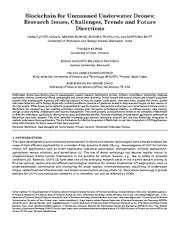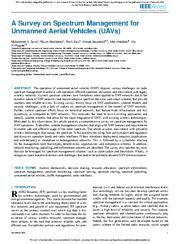A copy of this work was available on the public web and has been preserved in the Wayback Machine. The capture dates from 2022; you can also visit the original URL.
The file type is application/pdf.
Filters
Reinforcement Learning-based Trajectory Optimization for Data Muling with Underwater Mobile Nodes
2022
IEEE Access
This paper addresses trajectory optimization problems for underwater data muling with mobile nodes. ...
INDEX TERMS Underwater acoustic communications, data muling, autonomous underwater vehicles, autonomous surface vehicles, trajectory optimization, reinforcement learning. ...
In this paper, we propose a nearest-K reinforcement learning-based trajectory optimization for the data muling with underwater mobile nodes. ...
doi:10.1109/access.2022.3165046
fatcat:nfvf4yi2enaqxcmi45telnssbu
Multimodal Underwater Networks
2017
Proceedings of the International Conference on Underwater Networks & Systems - WUWNET'17
We conclude with an outlook on likely future developments for multimodal communications. ...
As the development of non-acoustic underwater communications is taking momentum, so is the research on how to optimally exploit the multimodal communications capabilities in different scenarios. ...
ACKNOWLEDGMENT This research was sponsored in part by the NATO Science for Peace and Security Programme under grant G5293. ...
doi:10.1145/3148675.3152759
dblp:conf/wuwnet/CampagnaroFCDZ17
fatcat:keju46aqqnbpdll4bnahg6ukcq
Multi-Agent Reinforcement Learning for Pragmatic Communication and Control
[article]
2023
arXiv
pre-print
Goal-oriented communication is a possible solution for this problem: communication decisions should be optimized for the target control task, providing the information that is most relevant to decide which ...
Efficient coordination between mobile robots requires reliable wireless transmission in highly dynamic environments, often with strict timing requirements. ...
Data Muling In the data muling scenario, the AUV has to visit a set of underwater floating nodes to recover their data through high-throughput short-range optical communications [38] before reaching ...
arXiv:2302.14399v1
fatcat:gxhgonq5tbf4zdkjbbneronz5e
A Survey of Wireless Sensor Network Architectures
2012
International Journal of Computer Science & Engineering Survey
In this survey, we classify existing WSN architectures into specific groups based on WSN behaviour and data flow characteristics. ...
Existing architectures are described and presented along with their advantages and disadvantages. ...
Next, the sink nodes send the request for data through the most optimal path, effectively reinforcing the path through which it would like data to go. ...
doi:10.5121/ijcses.2012.3601
fatcat:4nq5s4xycjhw7kg2qb6v5e4wci
Mobility in Wireless Sensor Networks
[chapter]
2008
Algorithms and Protocols for Wireless Sensor Networks
Data communications. Ad hoc data communication is typically peer-to-peer. One node that wishes to communicate with one or more nodes does so using one of the many available protocols. ...
These nodes can be either static or mobile, and are usually constrained as for the most critical resources, such as power and computation capabilities. ...
Sensor nodes learn about the sink whereabouts at given times via statistics techniques as well as methods from distributed reinforcement learning. ...
doi:10.1002/9780470396360.ch10
fatcat:jisym5lnqrgntcv2dgivfcco3i
Blockchain for Unmanned Underwater Drones: Research Issues, Challenges, Trends and Future Directions
[article]
2022
arXiv
pre-print
The key limitations for effective integration of Blockchain in real-time integration in UUD applications, along with directions for future research have been presented. ...
While drones can be explicitly programmed for specific missions, data security and privacy are crucial issues of serious concern. ...
Based on multi-agent reinforcement learning, authors in [43] formulated an adaptive and distributed algorithm for managing the resource for IoUTs. ...
arXiv:2210.06540v1
fatcat:drxujo5v3vfnrfrkbgges32p5u
A survey of adaptive services to cope with dynamics in wireless self-organizing networks
2012
ACM Computing Surveys
Finally, we discuss open research problems to encourage the design of novel protocols for WSONs. ...
due to lack of centralized management, device heterogeneity, unreliable wireless communication, mobility, resource constraints, or the need to support different traffic types. ...
Using reinforcement learning, nodes react to network dynamics and the changes in their budgets. ...
doi:10.1145/2333112.2333118
fatcat:rn2frgzuevfxzkubsjxwzbvive
Automatic mobility status estimation in wireless self-organised networks
2011
Journal of computer and system sciences (Print)
The Self-Detection of Mobility Status algorithm (SDMS) uses a reinforcement learning inspired mechanism to combine the indications from five mobility metrics. ...
For many applications of these systems the mobility status of devices forms part of the operating context on which self-organisation is based. ...
Identifying potential data mules to carry data between isolated groups of devices [11] , as in 'pocket switching' with mobile phones [12] . ...
doi:10.1016/j.jcss.2010.01.009
fatcat:cmg2q53xqncxxk2qomd5h2b6ya
A Survey on Spectrum Management for Unmanned Aerial Vehicles (UAVs)
2021
IEEE Access
The survey also specifies key tools that can be leveraged for spectrum management solutions such as optimization and blockchain. ...
This motivates the need to revisit existing approaches and identify suitable schemes that allow for the rapid integration of UAVs with existing wireless technologies. ...
stations/data mule), delivery/transportation, and construction. ...
doi:10.1109/access.2021.3138048
fatcat:2h5ls7ywo5g3bbz454gqatvkw4
Effective Heuristics for Route Construction of Mobile Data Collectors
[chapter]
2009
Mobile Robots - State of the Art in Land, Sea, Air, and Collaborative Missions
A grid type topology is assumed for the network deployment with sensors located at the grid intersection points, where the mobile entities (data mules) can move in any of the four directions with equal ...
The sensor nodes learn the times at which they have connectivity with the vehicle, and wake up accordingly to transfer their data. ...
doi:10.5772/6996
fatcat:c6ojtimgjfcudijuj5bwwad3wq
From Delay-Tolerant Networks to Vehicular Delay-Tolerant Networks
2012
IEEE Communications Surveys and Tutorials
solution for non realtime applications. ...
Delay-Tolerant schemes and protocols can help in situations where network connectivity is sparse or with large variations in density, or even when there is no end-to-end connectivity by providing a communications ...
Some interesting new types of nodes in VDTNs are data MULEs (Mobile Ubiquitous LAN Extensions) [45] and stationary relay nodes [46] . ...
doi:10.1109/surv.2011.081611.00102
fatcat:nqpkmg6fnfabppz56wa3iinhzu
Underwater Optical Wireless Communications in Swarm Robotics: A Tutorial
2021
IEEE Communications Surveys and Tutorials
Since our focus is on AUV swarms and therefore on mobility, however, in the remainder only LED-based solutions will be explored. ...
With ultra long-wavelength radio (< 3 kHz) significant distances can be covered, at the expense of huge antenna sizes, low data rates, and high transmit powers, which is beyond the scope of AUV swarms. ...
The authors would like to thank the anonymous reviewers for constructive comments that improved the quality of the manuscript. ...
doi:10.1109/comst.2021.3111984
fatcat:dbu6v37agnaa7o46emq4qjjc4q
NeBula: Quest for Robotic Autonomy in Challenging Environments; TEAM CoSTAR at the DARPA Subterranean Challenge
[article]
2021
arXiv
pre-print
We discuss the specific results and lessons learned from fielding this solution in the challenging courses of the DARPA Subterranean Challenge competition. ...
system; (iii) traversability analysis and local planning; (iv) global motion planning and exploration behavior; (i) risk-aware mission planning; (vi) networking and decentralized reasoning; and (vii) learning-enabled ...
Acknowledgments The work is partially supported by the Jet Propulsion Laboratory, California Institute of Technology, under a contract with the National Aeronautics and Space Administration (80NM0018D0004 ...
arXiv:2103.11470v4
fatcat:rq2wgczzl5clphzgujjdbd3ywm
Controlled sink mobility for prolonging wireless sensor networks lifetime
2007
Wireless networks
The different mobility schemes are compared through extensive ns2-based simulations in networks with different nodes deployment, data routing protocols, and constraints on the sink movements. ...
More specifically, for WSNs that comprise a large number of statically placed sensor nodes transmitting data to a collection point (the sink), we show that by controlling the sink movements we can obtain ...
Acknowledgments This work was supported in part by the European FP6 027227 IP Project "E-Sense (Capturing Ambient Intelligence for Mobile Communications through Wireless Sensor Networks)." ...
doi:10.1007/s11276-007-0017-x
fatcat:f3wiurqyivfjzoiultq2d2vgui
Maritime Networking: Bringing Internet to the Sea
2019
IEEE Access
Unlike land vehicles, maneuver at sea is affected by sea surface movement and wave occlusions, which can cause unstable environment with a high rate of link breakages caused by low link stability, as well ...
Intermediate nodes, which serve as data mules, receive and buffer packets (e.g., can store up to 200 packets [13] ), wait for opportunities to establish connection to next-hop nodes, and transmit the ...
INTEGRATION OF UNDERWATER NETWORKING INTO MARITIME NETWORKING Underwater networks use acoustic wave propagation, which is susceptible to noises, for underwater communication (see Section II-D for more ...
doi:10.1109/access.2019.2909921
fatcat:ms33xi2s5zhwncqvxlf5andr2a
« Previous
Showing results 1 — 15 out of 33 results















